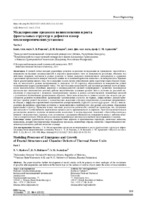| dc.contributor.author | Рыжова, Т. В. | |
| dc.contributor.author | Бухаров, Д. Н. | |
| dc.contributor.author | Аракелян, С. М. | |
| dc.coverage.spatial | Минск | ru |
| dc.date.accessioned | 2023-08-10T07:52:05Z | |
| dc.date.available | 2023-08-10T07:52:05Z | |
| dc.date.issued | 2023 | |
| dc.identifier.citation | Рыжова, Т. В. Моделирование процессов возникновения и роста фрактальных структур и дефектов камер теплоэнергетических установок. Часть 2 = Modeling Processes of Emergence and Growth of Fractal Structures and Chamber Defects of Thermal Power Units. Part 2 / Т. В. Рыжова, Д. Н. Бухаров, С. М. Аракелян // Наука и техника. – 2023. – № 4. – С. 333-341. | ru |
| dc.identifier.uri | https://rep.bntu.by/handle/data/133573 | |
| dc.description.abstract | В данной статье находят дальнейшее развитие модельные исследования по проведению аналогий возникновения возможных неоднородностей и дефектов фрактального типа на поверхности различных объектов под действием лазерного излучения в разных условиях и схемах лазерного имитационного эксперимента в сравнении с реальными процессами в камерах тепловых машин из-за контактов рабочего вещества с их поверхностью. Предмет такого рассмотрения связан с тем, что в лазерных схемах можно относительно легко и регулируемым образом управлять их топологией в разных модификациях (в диапазоне 1D–3D структур, образующихся на поверхностях разной геометрической формы фрактального типа). Это дает большие возможности для изучения различных часто возникающих нежелательных случайных дефектов и неоднородностей сложной конфигурации с развитием неожидаемых процессов при динамических режимах работы энергетических установок разного типа в условиях их реальной эксплуатации и определяется с помощью геометрического анализа в рамках соответствующих нелинейных моделей с различными нелинейными фрактальными образами. Нами использовались в данном аспекте две модели для рассмотрения развития возникающих фрактальных трещиноватых структур: во-первых, диффузионное распространение/рост трещин разной геометрии с совокупностью локальных отрезков и фрагментов в различных направлениях; во-вторых, с диффузно-ограниченной агрегацией их распространения (Diffusion-Limited Aggregation – DLA) с использованием формализма клеточных автоматов в перколяционном приближении для разных алгоритмов образования фрактальных структур. Приведем только итоговые результаты расчетов без деталей их процедуры, что достаточно для наглядного и качественного определения процесса роста трещиноватости и дефектов. При этом конечной целью рассмотрения является изучение возникновения возможных и контролируемых локальных областей/коллекторов, начиная с поверхностных структур, и их ассоциация с реальными объектами на поверхности камер с рабочим веществом в энергосистемах. Обсуждается возможная практическая значимость подобного моделирования и анализа. Ключевые слова: фрактальные модели, поверхностные дефекты и трещиноватые структуры, клеточные автоматы, перколяция, лазерно-индуцированные управляемые процессы, нелинейные образы, аналогия с энергетическими тепловыми установками, рабочее вещество в камере. | ru |
| dc.language.iso | ru | ru |
| dc.publisher | БНТУ | ru |
| dc.title | Моделирование процессов возникновения и роста фрактальных структур и дефектов камер теплоэнергетических установок. Часть 2 | ru |
| dc.title.alternative | Modeling Processes of Emergence and Growth of Fractal Structures and Chamber Defects of Thermal Power Units. Part 2 | ru |
| dc.type | Article | ru |
| dc.identifier.doi | 10.21122/2227-1031-2023-22-4-333-341 | |
| local.description.annotation | The paper describes further development of model studies with the purpose to draw analogies of the occurrence of possible inhomogeneities and defects of the fractal type on the surface of various objects under the action of laser radiation for different conditions and schemes of a laser simulation experiment in comparison with real processes in the chambers of thermal machines due to the contacts of the working substances with their surface. The subject of this consideration is related to the fact that in laser schemes one can relatively easily and in a controlled manner to study their topology in various modifications (in the range of 0D–3D structures formed on surfaces of various geometric shapes of the fractal type). This provides great opportunities for studying various frequently occurring undesirable random defects and inhomogeneities of complex configuration with the development of unexpected processes in the dynamic modes of operation of various types of power units in their actual operation. This is determined by geometric analysis within the framework of the correspondding non-linear models with different non-linear fractal images. In this aspect, we have used two models to consider the development of emerging fractal fractured structures: first, diffusion propagation/growth of cracks of different geometry with a set of local segments and fragments in different directions; secondly, with diffusely limited aggregation of their distribution (Diffusion-Limited Aggregation – DLA) using the formalism of cellular automata in percolation approximation for different algorithms for the formation of fractal structures. We present only the final results of calculations without details of their procedure, which is sufficient for a visual and qualitative determination of the process of growth of fracturing and defects. In this case, the final goal of consideration is to study the emergence of possible and controllable local areas / collectors, starting from surface structures, and their association with real objects on the surface of chambers with a working substance in power systems. The possible practical significance of such modeling and analysis is discussed to forecast their working conditions. | ru |

